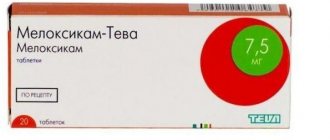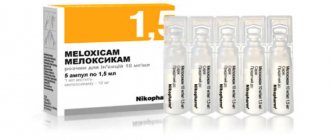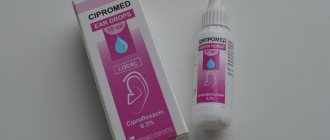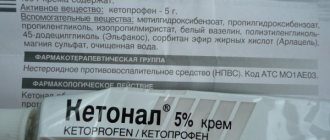pharmachologic effect
A non-steroidal anti-inflammatory drug (NSAID), it belongs to enolic acid derivatives and has anti-inflammatory, analgesic and antipyretic effects. The pronounced anti-inflammatory effect of meloxicam has been established in all standard models of inflammation.
The mechanism of action of meloxicam is its ability to inhibit the synthesis of prostaglandins, known mediators of inflammation. In vivo, meloxicam inhibits prostaglandin synthesis at the site of inflammation to a greater extent than in the gastric mucosa or kidneys. These differences are associated with more selective inhibition of COX-2 compared to COX-1. Inhibition of COX-2 is thought to provide the therapeutic effect of NSAIDs, whereas inhibition of the constitutively present COX-1 isoenzyme may be responsible for gastric and renal side effects.
The selectivity of meloxicam for COX-2 has been confirmed in various test systems, both in vitro and ex vivo. The selective ability of meloxicam to inhibit COX-2 was demonstrated when using human whole blood as a test system in vitro. Ex vivo it was found that meloxicam (in doses of 7.5 mg and 15 mg) more actively inhibited COX-2 (having a greater inhibitory effect on the production of prostaglandin E2, stimulated by lipopolysaccharide (reaction controlled by COX-2/) than on the production of thromboxane, which is involved in the process blood clotting (reaction controlled by COX-1). These effects were dose dependent. Ex vivo it was shown that meloxicam at recommended doses did not affect platelet aggregation and bleeding time, in contrast to indomethacin, diclofenac, ibuprofen and naproxen, which significantly suppressed platelet aggregation and increased bleeding time.
In clinical studies, gastrointestinal side effects generally occurred less frequently with meloxicam 7.5 mg and 15 mg than with other NSAIDs compared. This difference in the frequency of side effects from the gastrointestinal tract is mainly due to the fact that when taking meloxicam, such phenomena as dyspepsia, vomiting, nausea, and abdominal pain were observed less frequently. The incidence of upper gastrointestinal perforations, ulcers, and bleeding associated with meloxicam use was low and dose-related.
Mechanism of action of Meloxicam
Meloxicam tablets block the synthesis of prostaglandins. These fat-soluble substances increase in quantity in response to inflammatory reactions. They are called inflammatory mediators. Previously, to combat the increased production of prostaglandins, drugs were used, under the influence of which bronchospasms and allergic reactions developed.
The drug belongs to a new generation of medications that selectively inhibit COX-2. This significantly reduced the risk of complications. The active substance of the same name is evenly distributed throughout the tissues and has a prolonged reaction. Successfully penetrates into synovial fluid.
The drug Meloxicam prevents lipid oxidation and the formation of free radicals. However, it does not change the structure of the cartilage; this effect was found when taking other tablets of similar action, but of earlier generations.
Pharmacokinetics
Meloxicam exhibits linear pharmacokinetics in doses of 7.5-15 mg when administered orally.
Suction
Meloxicam is well absorbed from the gastrointestinal tract, as evidenced by its high absolute bioavailability when taken orally (89%).
With a single dose of the drug, the average Cmax in plasma is achieved within 5-6 hours. With repeated use, a steady state of pharmacokinetics is achieved within 3 to 5 days. The range of differences between Cmax and Cmin of the drug during the period of steady-state pharmacokinetics after taking it once a day is relatively small and amounts to 0.4-1 mcg/ml for a dose of 7.5 mg and 0.8-2 mcg/ml for a dose of 15 mg. Cmax in plasma during the period of steady state pharmacokinetics is achieved within 5-6 hours.
Concentrations of the drug after continuous use of the drug for more than 6 months are similar to the concentrations observed after 2 weeks. oral administration at a dose of 15 mg/day When taken for more than 6 months, such differences are unlikely.
Concomitant food intake does not affect the absorption of the drug.
Distribution
Meloxicam binds well to plasma proteins, especially albumin (99%). Penetrates into synovial fluid, the concentration in synovial fluid is approximately 50% of the concentration in plasma. Vd is low, averaging 11 liters. Interindividual differences are 30-40%.
Metabolism
Meloxicam is almost completely metabolized in the liver to form 4 pharmacologically inactive derivatives. The main metabolite, 5′-carboxymeloxicam (60% of the dose), is formed by oxidation of an intermediate metabolite, 5′-hydroxymethylmeloxicam, which is also excreted, but to a lesser extent (9% of the dose). In vitro studies have shown that the CYP2C9 isoenzyme plays an important role in this metabolic transformation; the CYP3A4 isoenzyme is of additional importance. Peroxidase, the activity of which probably varies individually, takes part in the formation of the other two metabolites (constituting 16% and 4% of the drug dose, respectively).
Removal
It is excreted equally in feces and urine, mainly in the form of metabolites. In unchanged form, less than 5% of the daily dose is excreted in feces; in urine, unchanged, the drug is found only in trace amounts. The average T1/2 is 20 hours. Plasma clearance averages 8 ml/min.
Pharmacokinetics in special clinical situations
Failure of liver function, as well as mild or moderate renal failure, do not have a significant effect on the pharmacokinetics of meloxicam. In end-stage renal failure, an increase in Vd may lead to higher concentrations of free meloxicam, so in these patients the daily dose should not exceed 7.5 mg.
In elderly patients, the mean plasma clearance during steady state pharmacokinetics is slightly lower than in younger patients.
During a study of meloxicam in children, the pharmacokinetics of the drug was studied at doses used at a rate of 0.25 mg/kg. When comparing indicators in children of different ages (2-6 years, n=7 and 7-14 years, n=11), a trend towards lower Cmax (34% decrease) and AUC (28% decrease) was established in younger children , and drug clearance (adjusted for body weight) in this group of children was higher. Plasma concentrations of meloxicam are similar in older children and adults. In children of both age groups, T1/2 of meloxicam from plasma was the same and amounted to 13 hours, but slightly shorter than in adults - 15-20 hours.
In what cases is Meloxicam prescribed?
With arthrosis, ankylosing spondylitis and arthritis, inflammatory processes in the joints are accompanied by the following unpleasant symptoms:
- pain;
- increased temperature in the painful area;
- swelling;
- restriction of freedom of movement.
To relieve symptoms, the patient is often prescribed a course of treatment with Meloxicam, a non-steroidal anti-inflammatory drug. It may be recommended to the patient as part of a set of measures. Conveniently, it is enough to use Meloxicam once a day.
The drug is available in the following basic forms:
- rectal suppositories;
- solution for injections;
- pills.
The active substance of all these forms is meloxicam. Its action is aimed at inhibiting the production of enzymes involved in inflammatory processes. When taking the drug in any of these forms, the condition improves quite quickly. The drug is well absorbed (up to 90%). The undigested part is excreted naturally - through the urinary system and with feces.
For your information! Meloxicam is well absorbed into the blood, its maximum concentration when taken orally is reached after 6 hours.
Dosage regimen for the tablet form of the drug:
For osteoarthritis, the daily dose is 7.5, if necessary, the dose is increased to 15 mg/day
For rheumatoid arthritis and ankylosing spondylitis, the drug is prescribed at 15 mg/day; if a positive therapeutic effect is achieved, the dose can be reduced to 7.5 mg/day
In patients with an increased risk of adverse reactions, it is recommended to begin treatment with a dose of 7.5 mg.
In patients with severe renal failure on hemodialysis, the dose of Movalis® should not exceed 7.5 mg/day
For adolescents, the maximum dose is 0.25 mg/kg body weight.
The maximum daily dose is 15 mg.
The tablets should be taken during meals with water or other liquid.
Since the risk of adverse reactions depends on the dose size and duration of use, the drug should be used for the shortest possible time at the lowest possible effective dose.
The total daily dose of Movalis® in the form of tablets, suppositories and injections should not exceed 15 mg.
Dosage regimen for the injection form of the drug:
IM administration of the drug is indicated only during the first 2-3 days. Subsequently, treatment is continued using oral forms (tablets).
The recommended dose is 7.5 mg or 15 mg 1 time / day, depending on the intensity of pain and the severity of the inflammatory process.
The maximum recommended daily dose is 15 mg.
Since the potential risk of adverse reactions depends on the dose and duration of treatment, the lowest possible dose and duration of use should be used.
The drug is administered deep intramuscularly. IV administration of the drug is prohibited!
In patients with severe renal failure on hemodialysis, the dose of Movalis should not exceed 7.5 mg.
The total daily dose of Movalis®, used in the form of tablets, suppositories and injection solution, should not exceed 15 mg.
Given possible incompatibility, the injection solution should not be mixed in the same syringe with other drugs.
Meloxicam cost
Below you will find the average cost of the drug Meloxicam in its various types:
- Average price tablets : from 32 to 170 rubles. Depending on the dosage of tablets and their quantity in the pack, also on the country of manufacture.
- solution : average price from 130 to 440 rubles. Depending on the number of ampoules and country of origin.
- rectal suppositories : average price from 220 to 400 rubles. Depending on the number of candles in the package and the country of manufacture.
Side effect
Adverse events that were considered possible to be associated with the use of Movalis® are described below. Side effects, the connection of which with the use of the drug was regarded as possible, recorded with widespread use of the drug, are marked (*).
From the hematopoietic system: changes in the leukocyte formula, leukopenia, thrombocytopenia, anemia.
From the central nervous system: headache, dizziness, tinnitus, drowsiness, confusion*, disorientation*, mood changes*.
From the digestive system: gastrointestinal perforation, hidden or obvious gastrointestinal bleeding, possibly fatal, gastroduodenal ulcers, colitis, gastritis*, esophagitis, stomatitis, abdominal pain, dyspepsia, diarrhea, nausea, vomiting, constipation, bloating, belching, transient changes in liver function tests (for example, increased activity of transaminases or bilirubin), hepatitis*.
Allergic reactions: angioedema*, immediate hypersensitivity reactions (including anaphylactic* and anaphylactoid*), toxic epidermal necrolysis*, Stevens-Johnson syndrome*, erythema multiforme*, bullous dermatitis*, skin rash, urticaria, itching.
Dermatological reactions: photosensitivity.
From the respiratory system: bronchial asthma.
From the cardiovascular system: increased blood pressure, palpitations, feeling of a rush of blood to the face, swelling.
From the urinary system: acute renal failure*, changes in renal function (increased levels of creatinine and/or urea in the blood serum), urinary disorders, including acute urinary retention*, interstitial nephritis, glomerulonephritis, renal medullary necrosis, nephrotic syndrome*.
From the organ of vision: conjunctivitis*, visual impairment, incl. blurred vision*.
Contraindications to the use of MOVALIS®
- a history of symptoms of bronchial asthma, nasal polyposis, angioedema or urticaria after taking acetylsalicylic acid or other NSAIDs;
- peptic ulcer/perforation of the stomach and duodenum in the acute stage or recently suffered;
- Crohn's disease or ulcerative colitis in the acute phase;
- severe liver failure;
- severe renal failure (if hemodialysis is not performed);
- acute gastrointestinal bleeding, recent cerebrovascular hemorrhage, or an established diagnosis of diseases of the blood coagulation system;
- severe uncontrolled heart failure;
- therapy of perioperative pain during coronary artery bypass grafting;
- pregnancy;
- lactation (breastfeeding);
- children under 12 years of age (except for use with an established diagnosis of juvenile rheumatoid arthritis);
- hypersensitivity to the active ingredient or auxiliary components of the drug (there is a possibility of cross-sensitivity to acetylsalicylic acid and other NSAIDs).
Carefully:
- history of gastrointestinal diseases;
- congestive heart failure;
- renal failure;
- IHD;
- cerebrovascular diseases;
- dyslipidemia/hyperlipidemia;
- diabetes;
- peripheral arterial disease;
- elderly age;
- long-term use of NSAIDs;
- smoking;
- frequent drinking of alcohol.
special instructions
Patients with gastrointestinal diseases should be monitored regularly. If ulcerative lesions of the gastrointestinal tract or gastrointestinal bleeding occur, Movalis® should be discontinued.
Gastrointestinal bleeding, ulcers and perforations can occur during treatment at any time, both in the presence of warning symptoms or a history of serious gastrointestinal complications, and in the absence of these signs. The consequences of these complications are generally more serious in older people.
Particular attention should be paid to patients reporting the development of adverse events from the skin and mucous membranes, as well as hypersensitivity reactions to the drug, especially if such reactions were observed during previous courses of treatment. The development of such reactions is observed, as a rule, during the first month of treatment. In such cases, discontinuation of Movalis should be considered.
Like other NSAIDs, Movalis® may increase the risk of developing serious cardiovascular thrombosis, myocardial infarction, and angina, possibly fatal. This risk increases with long-term use of the drug, as well as in patients with a history of the above diseases and those predisposed to such diseases.
NSAIDs inhibit the synthesis of prostaglandins in the kidneys, which are involved in maintaining renal perfusion. The use of NSAIDs in patients with reduced renal blood flow or reduced volume may lead to decompensation of latent renal failure. After discontinuation of NSAIDs, renal function usually returns to baseline levels. Patients most at risk for this reaction are elderly patients, patients with dehydration, congestive heart failure, cirrhosis of the liver, nephrotic syndrome or acute renal impairment, patients concomitantly taking diuretics, and patients undergoing major surgery that lead to hypovolemia. In such patients, diuresis and renal function should be carefully monitored when initiating therapy.
The use of NSAIDs in combination with diuretics can lead to sodium, potassium and water retention, as well as a decrease in the natriuretic effect of diuretics. As a result, predisposed patients may experience increased signs of heart failure or hypertension. Therefore, such patients should be closely monitored and adequate hydration maintained. Before starting treatment, a kidney function test is necessary.
In case of combination therapy, renal function should also be monitored.
When using the drug Movalis®, episodic increases in the level of transaminases or other indicators of liver function in the blood serum have been reported. In most cases, this increase was small and transitory. If the identified changes are significant or do not decrease over time, Movalis® should be discontinued and the identified laboratory changes should be monitored.
Frail or malnourished patients may be less able to tolerate adverse events and should be monitored closely.
Meloxicam, like other NSAIDs, can mask the symptoms of an infectious disease.
The maximum recommended daily dose of 7.5 mg and 15 mg tablets contains 47 mg and 20 mg of lactose, respectively. Patients with rare hereditary galactose intolerance, lapp lactase deficiency or impaired glucose/galactose absorption should not take this drug.
In case of simultaneous use of anticoagulants for oral administration, ticlopidine, heparin for systemic use, thrombolytic agents, careful monitoring of the effect of anticoagulants is necessary.
Drug interactions
When used simultaneously with meloxicam, other inhibitors of prostaglandin synthesis, incl. GCS and salicylates (acetylsalicylic acid), the risk of gastrointestinal ulcers and gastrointestinal bleeding increases due to the synergistic action. Concomitant use of meloxicam and other NSAIDs is not recommended.
When meloxicam is used simultaneously with selective serotonin reuptake inhibitors, the risk of gastrointestinal bleeding may increase.
Due to the presence of sorbitol in Movalis, co-administration with sodium polystyrene sulfonate may cause a risk of developing necrosis of the large intestine, which can be fatal.
Anticoagulants for oral administration, antiplatelet agents, heparin for systemic use, thrombolytic agents, serotonin reuptake inhibitors when used simultaneously with Movalis increase the risk of bleeding due to inhibition of platelet function.
NSAIDs increase plasma lithium concentrations by decreasing renal excretion of lithium. It is recommended to monitor lithium levels during the period of prescribing Movalis® when changing the dose of lithium drugs and their discontinuation.
NSAIDs can reduce the tubular secretion of methotrexate, thereby increasing its plasma concentration and hematological toxicity, but the pharmacokinetics of methotrexate does not change. In this regard, simultaneous use of Movalis and methotrexate at a dosage of more than 15 mg/week is not recommended.
The risk of interaction between NSAIDs and methotrexate may also occur in patients using low doses of methotrexate, especially in patients with impaired renal function. Therefore, constant monitoring of the number of blood cells and kidney function is necessary. When meloxicam and methotrexate are used together for 3 days, the risk of increased toxicity of the latter increases.
NSAIDs reduce the effectiveness of intrauterine contraceptive devices.
The use of NSAIDs while taking diuretics in case of dehydration of patients is accompanied by a risk of developing acute renal failure.
Antihypertensive drugs (beta-blockers, ACE inhibitors, vasodilators, diuretics), NSAIDs reduce the effect of antihypertensive drugs due to inhibition of prostaglandins that have vasodilating properties.
The combined use of NSAIDs and angiotensin II receptor antagonists enhances the effect of reducing glomerular filtration. In patients with impaired renal function, this may lead to the development of acute renal failure.
Cholestyramine, by binding meloxicam in the gastrointestinal tract, leads to its faster elimination.
NSAIDs, by acting on renal prostaglandins, may enhance the nephrotoxicity of cyclosporine.
When using medicinal products with a known ability to inhibit CYP2C9 and/or CYP3A4 (or are metabolized by these enzymes) with meloxicam, the possibility of pharmacokinetic interaction should be taken into account.
The possibility of interaction with oral hypoglycemic drugs cannot be excluded.
With the simultaneous use of antacids, cimetidine, digoxin and furosemide, no significant pharmacokinetic interaction was detected.
Analogues and other information
Among the analogues are many drugs from the NSAID group, which are presented in pharmacies.
| A drug | Active substances | Price, rubles |
| Diclofenac | Diclofenac | 150 |
| Nimesulide | Nimesulide | 170 |
| Movalis | Meloxicam | 700 |
| Meloflex | Meloxicam | 360 |
| Liberum | Meloxicam | 350 |
| Flexibon | Meloxicam | 280 |
The drug combines well with muscle relaxants (Mydocalm, Sirdalud, Tizanil), therefore it is often prescribed together with them for the treatment of joint, muscle, and vertebrological pathologies.
The therapeutic effect of the analogues, which are available in the form of a solution for intramuscular administration, is the ability to suppress inflammation localized in muscle and joint tissues, as well as relieve syndromes associated with the activity of the inflammatory process. Tablet forms of NSAIDs also have a similar effect, including:
- tablets Ibuprofen, Nimesulide, Arcoxia, Airtal;
- ointments and gels for external use Voltaren, Diclofenac, Nise gel.
The pharmacological action of oral and local agents is aimed at inhibiting the synthesis of prostaglandins - inflammatory mediators that stimulate pain and fever.
Comparison of Meloxicam and Movalis
Since a doctor or pharmacist often offers a choice of Meloxicam or Movalis, which is more effective and which drug to give preference remains a subject of open debate. The differences in these products are practically invisible, since the main active ingredient in them is meloxicam. The difference between the drugs lies in the manufacturer and brand.
The pharmacology and composition of Movalis and Meloxicam injections are completely identical.
The pioneer of the line is the substance meloxicam, which was first synthesized by the German company Boehringer Ingelheim. The company launched it on the market as part of the drug Movalis in 1995.
A line of drugs under the trade name Meloxicam is produced by analogy with the original drug in many countries - among the drug manufacturers are Teva Israel, Hemofarm Serbia, Vertex Russia, etc.










